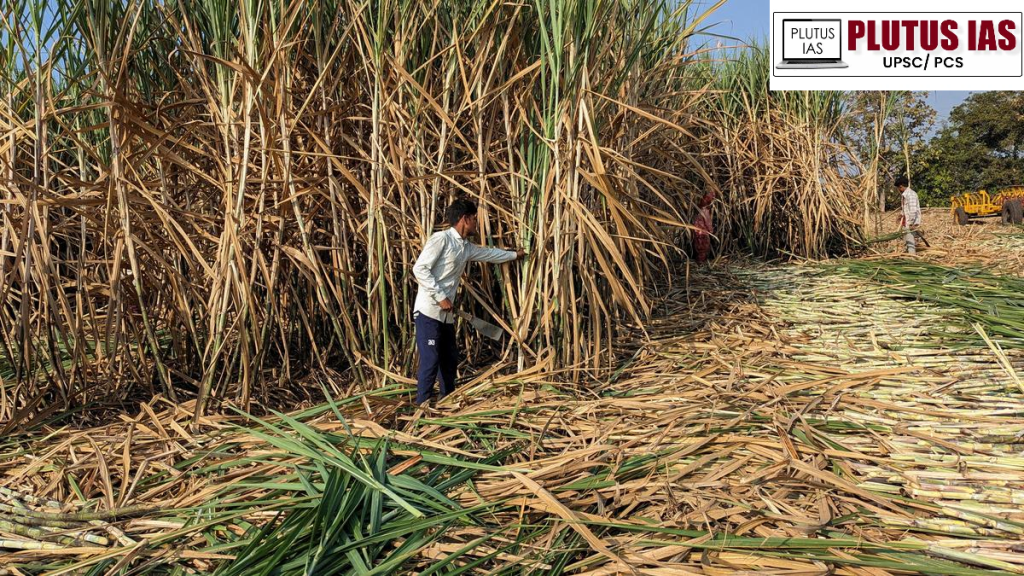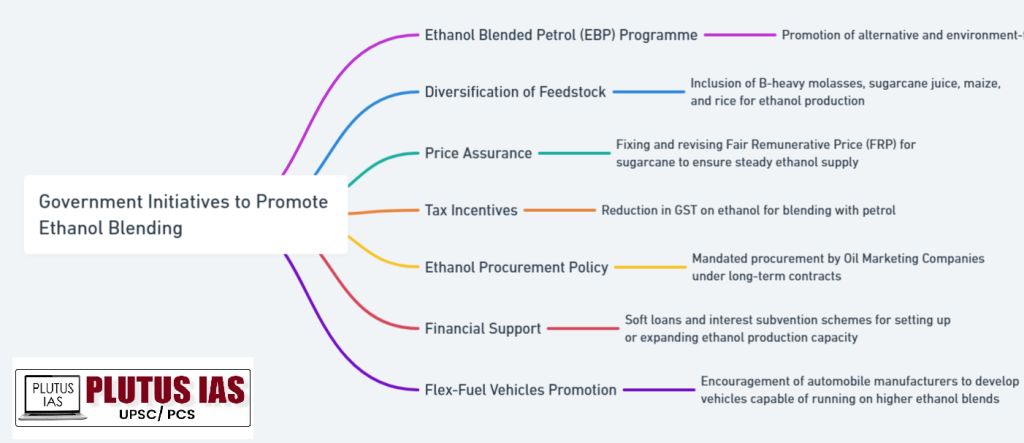08 May Food vs fuel: The ethanol blending dilemma
This article covers “Daily Current Affairs” and the Topic Food vs fuel: The ethanol blending dilemma
SYLLABUS MAPPING:
GS-3- Environment- Food vs fuel: The ethanol blending dilemma
FOR PRELIMS
What is ethanol blending? Discuss its advantages and challenges in the Indian context.
FOR MAINS
What are the challenges of using food crops for ethanol production?
Why in the News?
India has achieved its ethanol-blending target of 20% in petrol ahead of the 2025 deadline and is now aiming to raise the target to 30% to reduce fossil fuel dependence. However, this push comes amid a decline in sugarcane production since 2022, leading to increased diversion of sugar for ethanol production. To support farmers, the government recently approved a hike in the Fair Remunerative Price (FRP) for sugarcane. This shift has contributed to a rise in retail sugar prices, raising concerns about its availability for direct consumption and its impact on consumers.

What is Ethanol blending?
Ethanol blending refers to mixing ethanol, a biofuel made from plant-based sources like sugarcane molasses, maize, and rice, with petrol to create a cleaner-burning fuel. This process reduces India’s dependence on fossil fuels, lowers carbon emissions, and enhances energy security. The Government of India launched the Ethanol Blended Petrol (EBP) Programme in 2003, aiming initially for 10% blending by 2022, which was achieved ahead of schedule. As of 2024, ethanol blending stands at around 15%, with a target to reach 20% (E20) by 2025. Ethanol production capacity has more than doubled in recent years, reaching over 1,600 crore litres in 2024, supporting this ambitious goal. This initiative has saved over ₹1 lakh crore in foreign exchange and reduced CO2 emissions by 544 lakh metric tons, while also boosting farmers’ incomes and rural economies.
The status of ethanol blending and the Government initiatives


Why Nudge for Ethanol Blending
1. Energy Security and Import Reduction: India is heavily dependent on crude oil imports (over 85% of its needs). Ethanol blending helps reduce this dependency, saving valuable foreign exchange.
2. Environmental Sustainability: Ethanol is a clean-burning biofuel that reduces greenhouse gas emissions and air pollutants. It supports India’s commitments under the Paris Agreement and its net-zero targets.
3. Utilisation of Agricultural Surplus: It provides a productive use for excess sugarcane, grains, and other feedstocks.Prevents wastage and supports price stabilisation in the agricultural sector.
4. Doubling Farmers’ Income: Ethanol production offers an additional revenue stream to farmers through higher Fair Remunerative Prices (FRP) for sugarcane. Reduces over-reliance on traditional crop markets and mitigates distress sales.
5. Promotion of Circular Economy: Utilises agricultural by-products like B-heavy molasses and damaged grains for fuel production. Encourages sustainable resource use and waste-to-energy models.
6. Industrial and Rural Development: The Establishment of ethanol plants creates jobs and boosts the rural economy. Attracts investment in the agro-processing and renewable energy sectors.
7. Global Commitments and Blending Targets: India has committed to achieving 30% ethanol blending by the early 2030s. Accelerated targets (20% by 2025 achieved ahead of time) reflect this urgency
Ethanol blending is a threat to food Security
1. Diversion of Food Crops: Sugarcane, maize, and broken rice are increasingly used for ethanol, reducing availability for consumption.
2. Rising Prices: Sugar prices rose from ₹40/kg (May 2022) to ₹45/kg (May 2025) due to higher diversion for ethanol.
3. Declining Output: Sugarcane production fell from 490 crore tonnes (FY23) to 435 crore tonnes (FY25), tightening supply.
4. Policy-Induced Shifts: Incentives like higher FRP push farmers to grow ethanol crops over food crops, affecting food diversity.
5. Impact on the Poor: Diverting grains affects PDS and nutrition for the vulnerable, worsening food insecurity.
6. Resource Strain: Water-intensive crops like sugarcane add to water stress, impacting sustainable agriculture.
7. Global Concerns: FAO warns that excessive biofuel use can deepen food crises in developing nations.
Balancing food vs fuel security
| Aspect | Food Security Concerns | Fuel Security Benefits |
|---|---|---|
| Land Use | Ethanol production requires large farmland, equal to Bihar’s cropped area, reducing land for food crops. | Helps reduce dependence on imported fossil fuels by using domestic crops for ethanol. |
| Feedstock | Uses food grains like sugarcane, maize, and rice, diverting them from the food supply. | Promotes the use of surplus/damaged grains, molasses, and agricultural residues for ethanol. |
| Impact on Food Prices | Diversion of food crops for ethanol raises food prices, affecting affordability for consumers. | Reduces fuel import bills (saving ₹1 lakh+ crore), which stabilises energy and inflationary pressures. |
| Water Usage | Crops like sugarcane and paddy are highly water-intensive, straining groundwater. | Encourages a shift to less water-intensive crops like maize and sorghum. |
| Production Capacity | Declining sugarcane production (due to diseases and climate) affects the food and ethanol supply balance. | Ethanol production capacity doubled to 1,600+ crore litres (2024), supporting 20% blending target. |
| Environmental Impact | Overuse of food crops may lead to unsustainable farming and environmental degradation. | Ethanol blending cuts CO₂ emissions by 544+ lakh metric tons, supporting India’s climate commitments. |
Conclusion
India’s push for higher ethanol blending aims to improve energy security and reduce carbon emissions, while boosting rural development. However, increasing ethanol production raises food security concerns as crops like sugarcane, maize, and rice are diverted for fuel, driving up food prices and affecting availability. To balance food and fuel security, the government needs to ensure efficient use of agricultural resources, promote less water-intensive crops, and protect vulnerable populations from rising food costs. By adopting sustainable farming practices, India can achieve its clean energy goals without compromising food security.
Download Plutus IAS Current Affairs (Eng) 08th May 2025
Prelims Questions
Q. Consider the following statements:
1. Ethanol blending in India helps reduce dependency on fossil fuels.
2. The target for ethanol blending in India is to reach 30% by 2025.
3. Sugarcane is the only crop used for ethanol production in India.
How many of the statements given above are correct?
A. Only one
B. Only two
C. All three
D. None
Answer: A
Mains Questions
Q. Discuss the challenges and benefits of ethanol blending in India, focusing on its impact on energy security, agriculture, and food security.
(250 words, 15 marks)




No Comments